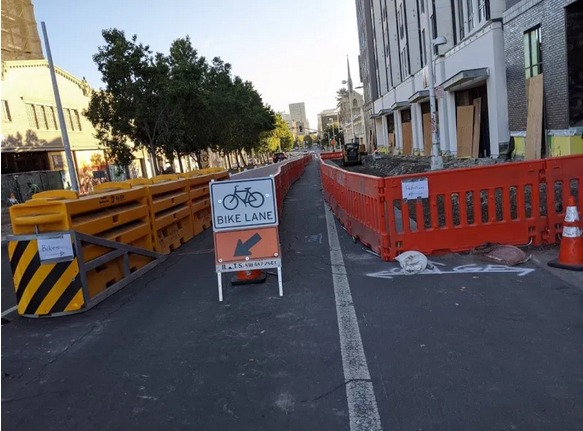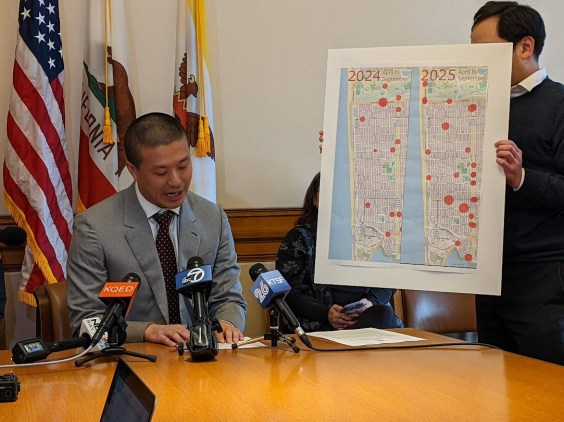Note: GJEL Accident Attorneys regularly sponsors coverage on Streetsblog San Francisco and Streetsblog California. Unless noted in the story, GJEL Accident Attorneys is not consulted for the content or editorial direction of the sponsored content.
Oakland is now home to arguably the safest quick-build bike lane in the Bay Area. And it was installed in a place where cyclists, and indeed all road users, are often most at risk of injury: a construction zone.
On Broadway, between 29th and 28th, a construction crew installed a Jersey barrier on the left side of the bike lane. Normally, crews install them on the right, where they do nothing to protect cyclists from collisions with motorists and squeeze riders between cars and concrete.
Streetsblog has inquiries in to the City of Oakland to get more details, such as whether or not this this will become the default treatment for construction zones. But advocates said they were happy to see improving standards in Oakland for keeping cyclists safe in construction zones. "[I] thank those who spoke up and agitated for improvements, and thank OakDOT staff who listened and have become more proactive with new projects resulting in the accommodations that you noticed on Broadway and elsewhere," said Bike East Bay's Robert Prinz, in an email to Streetsblog. Prinz added that the protection plays a role in providing "...better access for people with disabilities, and prevents negative impacts on local business storefronts, so it's not just a bike/walk concern."
Advocates on both sides of the Bay have long lobbied for consistent and better protection for cyclists during construction projects.

"This does look encouraging," wrote advocate Dan Crosby of San Francisco, who lobbied to get safer treatments during work on San Jose Avenue. He said he was especially impressed by the signage. "On balance, this setup looks a lot safer than other construction diversions I've encountered," he said of the new treatment in Oakland.
Crosby also offered Streetsblog this poster-child of how not to sign and build construction detours for pedestrians and cyclists:
Meanwhile, Streetsblog hopes Oakland, San Francisco and other cities of the Bay Area will make this new Oakland treatment standard for construction zones. Extra attention has to be paid to the safety of cyclists and pedestrians when there are detours and construction materials and heavy equipment.
It should be noted that providing safe passage for all road users through construction areas doesn't cost more. Take a look at how it is usually done, with cyclists placed between moving cars and the concrete dividers, such as in this example on 27th in Oakland, just a few blocks away:
"City agencies can accommodate cyclists when they want to--it's just that most of the time we're an afterthought (or not thought of at all)," groused Bruce Halperin, another advocate who has focused on safety in construction zones. Streetsblog reported last week on an egregious case of "not though of at all" on Treasure Island, where construction crews completely marooned cyclists, providing no detours or alternatives whatsoever, for a six month freeway ramp construction project.
Oakland, meanwhile, has used robust, crash-proof temporary barriers to protect bike lanes before, on Clay Street, although in that case it was across the street from a construction site, and not really part of it. In that case they were used to keep motorists, including the city's own employees, from parking on the bike lane. But the example on Broadway between 28 and 29 is the first time in the Bay Area, at least to Streetsblog's knowledge, that a construction crew has fully protected a bike lane according to the best possible standards for a construction site.
It's a shame that the rest of Broadway depends on standard painted bike lanes along the parking lane.
Speaking of best standards, here's a video that shows the lengths they go to in the Netherlands to keep cyclists safe in construction zones. "In the Netherlands, separate bike lines are key in creating a safe and enjoyable bike experience for cyclists, young and old. During construction, safety is often under pressure because permanent measures are temporarily halted and the situation often changes. Therefore the Netherlands focuses on bringing different stakeholders together, before, during and after construction, to create a traffic situation that is safe and workable for all parties involved," wrote the Dutch Consul General in San Francisco, Dirk Janssen, in an email to Streetsblog.






